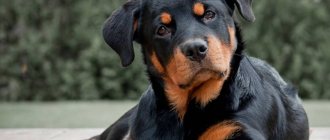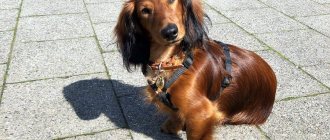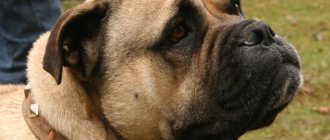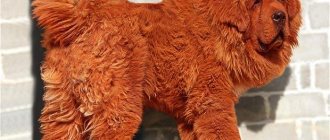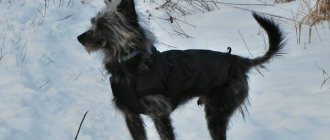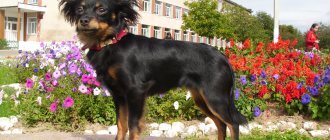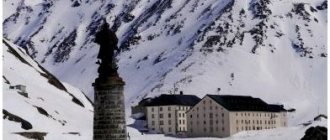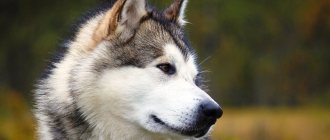Newfoundland is a large dog breed.
Despite the impressive size of an adult animal and its external resemblance to a bear, this kind dog is created for life in a family, where it occupies an honorable place among its other members, thanks to the lack of aggression towards humans and other animals.
History of Great Danes
Presumably the history of the breed dates back to 3000 BC. At that time, the Egyptians depicted large dogs, reminiscent in appearance of modern Great Danes.
Limestone figurine of Anubis. From excavations at Saqqara. Late period around 750 - 332. BC E.
In Chinese literature of 1121 BC. There were also descriptions of similar dogs.
Ancient pastoral tribes in Tibet domesticated mastiff-like dogs. It is believed that they became the ancestors of Great Danes and Asian Shepherds.
A little later, Tibetan dogs spread to India and China, and then to European countries, including Germany.
In the 10th century AD ancient Germanic tribes described seven species of mastiff dogs. Their purpose was to hunt boar and bear.
By the 15th century AD. the direct ancestors of Great Danes appeared. They had several names: Great Danes, Old Germanic Danes and Bullenbeisers.
The Great Dane had a number of its own characteristics: an elongated muzzle, a long neck, and an elegant body. By the end of the 19th century, Great Danes practically stopped being bred. Breeders gave preference to Great Danes.
Great Danes were officially recognized in 1871 in Germany. In 1880, the Germans banned the name "Great Dane" and named the breed "Deutsche Doe," meaning German Mastiff. However, in some countries the breed continues to be called the Great Dane.
Great Danes appeared in Russia thanks to Emperor Alexander II. At the Hamburg exhibition he acquired two dogs of this breed. However, they became widespread only in the 60s of the twentieth century.
Today, Great Danes are family pets and, despite their size, they get along well in an apartment.
Story
Even before the start of the Great Patriotic War in the thirties of the last century, the government that came to power was heading for the rapid restoration of the country after the shock of the civil and First World Wars. It was important to urgently restore production, agriculture, and mining industries. For everything planned, labor was required.
Not only people could work efficiently, but along with humans there were always their four-legged friends. Dogs helped move cargo, guard territories, protect warehouses from thieves, herds from predators, engage in shepherding, and serve at border and police posts.
In those days, it was easier to breed many European representatives of four-legged helpers on their own in special nurseries than to import them from abroad. The experiments affected not only the Newfoundland, but also the German Shepherd, St. Bernard and many others.
The Great Patriotic War only worsened the shortage of working dogs. There were no extra hands or paws at the front; everyone there made an important contribution to the upcoming victory. Large dogs were used on the battlefield quite often and had an extensive list of tasks. They helped transport the wounded , delivered cargo unnoticed, served as demolitions, and helped search for mines buried in the ground. The war claimed many lives and not only human ones, four-legged helpers died in the hundreds, and by the significant day of the great victory, almost all cynological feats had to be started anew.
To be precise, the decision to breed new species and the urgent need for them arose back in 1940. Some nurseries managed to maintain their functionality throughout the entire period of hostilities. The requirements were quite strict. What was needed was a fairly aggressive dog, subservient to its owner, easy to care for and able to withstand extreme cold.
It was assumed that they would serve at border posts in the north of the country. For the experiment, a Newfoundland was crossed with a female German shepherd. Later, after the appearance and approval of the Caucasian Shepherd Dogs, they replaced the German ones. And this replacement finally gave the result that Soviet breeders were striving for.
To read: The most charming shaggy cat Scottish Longhair: description and character of the breed
In 1955, the “divers” were solemnly presented to the general public as part of an exhibition festival. Their appearance was practically no different from the appearance of their progenitor; only a specialist could notice the difference. It was a typical service dog , bred artificially and did not become widespread among the general population, but it was not designed for that.
To a greater extent, the breeders hoped to use the animal on the water for search and rescue operations. And here it became clear that at some stage of the selection a mistake was made. The rescuers did not at all try to pull the drowning man out of the water; instead, they attacked him.
The breed was never recognized by the International Federation of Cynologists. In the Soviet Union, they were breeding it until the sixtieth year of the twentieth century. Further breeding was considered inappropriate. In fact, the result did not live up to expectations. By that time, working and watchdogs had already appeared that could cope with service in the far north, and “divers” turned out to be completely unsuitable for rescue operations on water.
For some time, after the official closure of state kennels, the Moscow city society of dog lovers worked, where our heroes, in particular, were engaged, but the continuation was short-lived. Over time, they simply disappeared into uncontrolled matings and today they simply do not exist. Although many, out of inertia, continue to call a completely different breed this way.
Features of Great Danes
The Great Dane group includes the following large breed varieties:
- Great Danes
- mastiffs
- bulldogs
- Saint Bernards
- Dalmatians
- Leonbergers
- Rottweilers
- Newfoundlands
All mastiffs have the following common characteristics:
- Exterior. All representatives of this group are large in size. The height at the withers of some representatives reaches 110 cm. The large weight is due to the muscular build and heavy bones.
- Anatomical structure. Great Danes have a special set of paws. The reason for this was the location of the shoulder blades relative to the chest.
- Frame. Powerful, with highly developed muscles. The chest is voluminous, the stomach is tucked.
- Head. Massive and heavy with a clear boundary between the forehead and muzzle. The jaws are square-shaped, the lips droop slightly. Some mastiffs have a shortened muzzle and drooping lips.
- Tail. It is long and has a slightly curved shape towards the tip.
- Wool. The main part of the group belongs to short-haired dogs. The exceptions are Leonbergers, St. Bernards, Newfoundlands and some mastiffs. The color depends on the type of breed and ranges from white to black. A distinctive feature of Great Danes is also the presence of skin folds on the body.
- Health. Many Great Danes have problems with the health of the musculoskeletal system. With insufficient walking and lack of proper diet, dogs are prone to obesity.
- Character. Almost all Great Danes have a calm and balanced temperament. However, when danger is detected, they turn into a real guard.
How Great Danes became dogs for aristocrats
Great Danes are often called the "king's dog." They received this title not only due to their aristocratic appearance. Their history is associated with popularity among high society.
Giant dogs lived in the palaces of Ancient Rome and were favorite pets of the highest nobility in Ancient China.
In the 18th century, the aristocrat dog was a prestigious guard for estates and carriages. It was also popular among the upper class for wild boar hunting.
Varieties of Great Dane breeds
The Fédération Cynologique Internationale identifies several main breeds of Great Danes. However, we will tell you not only about them, but also about their closest relatives, which belong to the mastiffs.
Dogo Argentino
| Country of origin | Argentina |
| Average weight | 40-45 kg |
| Average height at withers | 69-68 cm |
| How many years do they live | 10-12 years |
Dogo Argentinos are large, muscular dogs with long, strong limbs. High intelligence, quick reaction, physical strength and endurance make them excellent athletes.
The dog's body is slightly longer than its height at the withers. The chest is quite wide, the stomach is tucked. The muzzle has characteristic jowls.
Bred in tropical conditions, Dogo Argentinos have short, fine, white coats. Argentines are affectionate and loyal to their owner, but have a complex, capricious character.
This dog is not suitable for novice dog owners and requires early socialization and training.
Great Dane
| Country of origin | Great Britain |
| Average weight | 68-95 kg |
| Average height at withers | 69-76 cm |
| How many years do they live | 6-10 years |
The Great Dane (English Mastiff) is a giant breed of dog. These are the largest European Great Danes and the largest representatives of mastiffs.
This breed is characterized by heavy bones, a wide chest and a powerful, muscular neck. The head is square in shape with a flat forehead. The muzzle is short and flat.
The English Mastiff is a smooth-haired breed of dog with a thick undercoat. The color can be silver, apricot, fawn, brindle or sand.
A distinctive feature of the breed is the “black mask” on the muzzle.
The British are noble, affectionate and balanced. Aggression is not typical for these dogs, but their protective qualities have not been lost.
The English Great Dane's favorite pastime is lying on the sofa. Sports are not for him. The dog is perfect for any person.
Dogo Canario
| Country of origin | Spain |
| Average weight | 50-60 kg |
| Average height at withers | 56-66 cm |
| How many years do they live | 10-12 years |
Canarios are large dog breeds. They have an athletic build, the length of which exceeds the height at the withers.
The head of the Dogo Canario is massive, the muzzle is short and square, with slightly hanging lips.
Dogokanarios are short-haired dog breeds. Characteristic colors: fawn, brindle and black. The first two colors are characterized by the presence of a dark mask on the face.
Dogo Canarios have a terrifying appearance. However, these dogs are very affectionate and friendly with their family members, including children.
These dogs are quite wary of strangers and are ready to defend themselves at any moment.
Dogo Canarios combine phlegmatic and active temperament.
They will not bother you with the desire to play, but they will happily support any initiative of the owner.
Dogo Brasil
| Country of origin | Brazil |
| Average weight | 45-55 kg |
| Average height at withers | 65-75 cm |
| How many years do they live | 10-12 years |
The Dogo Brasil (Fila Brasilian, Fila Brasilian) is a large breed of dog.
The Fila Brasil is a short-haired dog. The standard allows any solid colors, except white, mouse gray, spotted and speckled. Brindle colors with light or dark stripes are also acceptable.
Fila can show open aggression towards strangers; this is inherent in her genes as an ideal guard.
At the same time, these Great Danes are very loyal dogs to their owner and never show aggression towards family members. Philos live to protect their owner.
Dogo Brazilis are not recommended for beginners in dog breeding and require early professional training.
German dog
| Country of origin | Germany |
| Average weight | 80-90 kg |
| Average height at withers | 75-80 cm |
| How many years do they live | 8-10 years |
The Great Dane is a giant breed of dog; its height at the withers can exceed 80 cm. They have a harmonious build and long, strong legs. The muzzle is quite voluminous, equal to half the length of the head.
The Great Dane is a breed with a dense and shiny coat, with no undercoat. Great Dane colors:
- pale yellow
- brindle
- marbled, spotted (white with black spots)
- blue
- black
The Great Dane's personality is cheerful, gentle and self-confident. These dogs are very devoted to their family. They are affectionate and kind towards children, but are quite wary of strangers.
The Great Dane is a great option for a non-aggressive family dog.
Tibetan mastiff
| Country of origin | China |
| Average weight | 64-78 kg |
| Average height at withers | 61-66 cm |
| How many years do they live | 10-15 years |
The Tibetan Mastiff (Tibetan Mastiff) is considered the ancestor of all representatives of the Great Dane. They belong to giant dog breeds.
Externally, Tibetan Great Danes resemble lions. Their distinctive feature is the fluffy coat along the contour of the head.
The dog's muscular back extends into a wide croup, and the ribs have a rounded shape. The head of mastiffs is quite large, the muzzle is square in shape.
Tibetan Mastiffs have thick, coarse hair and an undercoat. The dog has a mane in the head and neck area. Feathers are noticeable on the hind legs.
Among the standard colors are:
- golden
- black and tan
- black
Tibetans are able to work in any climate thanks to their wool.
Despite their size and menacing appearance, they are incredibly gentle and devoted to their owner. Fearless giants are always ready to protect their family and territory.
Representatives of this breed take a long time to mature, females by two years, and males by four.
Tibetan Mastiffs are recommended for experienced dog owners.
French Dogue
| Country of origin | France |
| Average weight | 55-70 kg |
| Average height at withers | 60-68 cm |
| How many years do they live | 8-10 years |
The Dogue de Bordeaux (French Dogue) is a giant dog breed. The oldest of all dogs bred in France.
They have a rather squat, muscular build. Their weight can reach 90 kg. The entire body of the Great Dane is covered with thick folds of skin.
The powerful “wrinkled” head is located on a short neck. The muzzle is standard for brachycephals - short and flattened.
Dogues de Bordeaux are short-haired dogs. The color includes all shades of red.
Brave and alert, Dogue de Bordeaux makes an excellent guard dog.
The French cannot live without their owner and endure his absence very painfully. They treat children with unprecedented affection and are quite friendly with other animals.
Suitable for experienced dog owners.
Dogo Neapolitan
| Country of origin | Italy |
| Average weight | 60-70 kg |
| Average height at withers | 60-75 cm |
| How many years do they live | 8-10 years |
The Dogo Neapolitan (Neapolitan Mastiff) is a gigantic dog. The oldest Italian breed has a massive build with heavy bones.
Their waddling gait resembles the movement of a bear or a large wild cat.
The breed is characterized by a large head with a flat muzzle. A distinctive feature of the breed is the abundance of skin folds on the face and head. A skin dewlap is required along the lower part of the body.
The Neapolitan's coat can be velvety in females and rough in males. Main colors:
- blue
- black
- grey
- Red tree
- Isabella (grey-fawn)
Mastinos never show aggression.
They can be used as guards, but the dog will never rush at an object that poses a danger; their tactic is to warn about their power.
Despite its menacing appearance and impressive size, the Dogo Neapolitan is a very affectionate, intelligent and balanced dog.
This dog breed will be an excellent family companion if you are ready to get such a large pet.
Great Dane
| Country of origin | China |
| Average weight | 12-25 kg |
| Average height at withers | 30-45 cm |
| How many years do they live | 10-12 years |
The Chinese Chongqing is an ancient small dog of the aboriginal type. These dogs come in three sizes: small, medium and large.
The muscular Chongqing dogs are a medium-sized breed. There are skin folds on the neck. The chest is quite deep and wide.
The body has a square shape due to the lack of tuck in the abdomen. The head is square in shape with pronounced cheekbones. The muzzle is folded and blunt in shape.
The coat of Chinese dogs is very short and rough, with no undercoat. The color usually has all shades of red and red, but black is also allowed.
The Great Dane is a breed that has a fairly high intelligence and has well-developed guarding qualities.
Chongqing dogs have a rather stubborn character and this means that it is better to entrust the training process to professionals.
These dogs do not get along well with other animals, especially cats. They are also not recommended for inexperienced owners.
Japanese Great Dane
| Country of origin | Japan |
| Average weight | 50-80 kg |
| Average height at withers | 55-65 cm |
| How many years do they live | 8-12 years |
The Great Dane (Japanese Mastiff, Tosa Inu) is the only Molosser from Japan. The breed was bred specifically to participate in dog fighting.
Today, Japanese Mastiffs are common as guard dogs and companions.
Tosa Inu are large in size and have a massive build. The head is wide with a pronounced transition between the forehead and muzzle. The muzzle is square in shape.
Japanese Great Danes are a short-haired breed. Acceptable colors:
- ginger
- apricot
- black
- pale yellow
- brindle
- black
Japanese dogs have a calm and patient character. In Japan they are called nannies because they show special love for children.
At the same time, Tosas do not tolerate their relatives and are very wary of strangers. They will not show aggression without a reason, only in case of danger.
This dog should be trained by a specialist.
Comparison with other large dogs
The Newfoundland is comparable in size to the Saint Bernard and Bernese Mountain Dog.
- The Saint Bernard is a rescue dog with a good sense of smell, designed to find people in snowy deserts.
- The Bernese Mountain Dog is a gentle and friendly dog with long, curly hair. There may be problems with training due to the dog's stubbornness. Despite his great love for children, he is capable of harming a baby due to his large size and clumsiness.
What to feed
Keeping Great Danes at home involves not only general dog care, but also nutritional care.
Almost all mastiffs have a tendency to obesity. Most often this is due to insufficient activity and poor diet.
Great Danes are recommended dry food for large or giant dog breeds, super premium or holistic class.
You can also add minerals and vitamins to your food to support overall health.
Content
“Divers” were taken out to be kept in military or working conditions. Naturally, it was not meant that he would become a pet and receive royal care. Therefore, one of the most important requirements was the dog’s unpretentiousness. We do not know what they were fed, but given the poverty of that period, it is unlikely that specialized food was developed.
Nowadays, keeping even such a large pet is not particularly difficult. It is not recommended to have such a pet in an apartment , since the animal requires a separate space.
Every time you return from a walk, you should wash him (at least wash his paws) and this will have to be done in the bathtub, which will also need to be cleaned each time before you use it. In addition, a large animal locked within four walls can save you from boredom either by destroying your property or by frequent and long walks.
A short haircut can be a salvation from long hair with a thick undercoat, especially in the warm season. The owner can become a stylist for his pet if he purchases a trimmer. Choosing the right diet should not be difficult either. Today, premium food manufacturers have made sure that your pets have a balanced daily diet.
To read: Smart and kind miniature schnauzer: a pet that will never let you get bored
Rare and unrecognized varieties of the Great Dane breed
Let's look at unrecognized and extinct varieties of Great Danes.
Muscovy dog
| Country of origin | Russia |
| Average weight | 40-45 kg |
| Average height at withers | 65-70 cm |
| How many years do they live | 8-10 years |
The Muscovy Great Dane is an experimental breed of domestic breeders and was obtained by crossing Great Danes with East European Shepherds.
According to the 1960 standard, Muscovy Great Danes had a strong and lean constitution with a massive but not coarse bone structure. The head had a flat forehead with a smooth transition to a pointed muzzle.
The Muscovy Dog's coat was thick and coarse with a dense undercoat. Color:
- all shades of red
- brindle
- black
All colors allowed the presence of a white spot on the chest and white paws.
Muscovy dogs had a calm, balanced character with protective qualities.
The breed was not continued in breeding, since very few puppies from this selection fit the standard.
Most of them looked like ordinary shepherd mixes.
Alanian Great Dane
| Country of origin | Spain |
| Average weight | 38-45 kg |
| Average height at withers | 55-65 cm |
| How many years do they live | 10-12 years |
The Alanian Dog (Alano) is one of the oldest indigenous dog breeds. The breed is one of the ancestors of modern Molossers.
At one time the breed was considered extinct, but at the end of the 20th century they were revived thanks to the initiative of a group of dog handlers.
The physique of the Alanian Great Dane is similar to the standard for Molossians, but drier and lighter. The head is distinguished by a pronounced frontal line and stop. The muzzle is short and standard for brachycephalic dogs.
Alanos have short, coarse fur. Any color is allowed, but any shades of brindle are preferred.
Alano's character is balanced and calm. However, dogs have a strong sense of leadership and love to dominate.
The breed is suitable for an experienced dog breeder with a strong character; the dog will perceive such an owner as a leader and obey him unquestioningly.
Representatives of the breed are patient with children, but wary of strangers. Aggression is not typical for these dogs, but Alanos will always protect their owner’s family and will be ready to fight back against attacks from other dogs.
South African Great Dane
| Country of origin | South Africa |
| Average weight | 60-90 kg |
| Average height at withers | 60-70 cm |
| How many years do they live | 9-11 years |
The African Great Dane (Boerboel, South African Mastiff) is a giant dog breed not recognized by the FCI. Their task was to protect farms and hunt large predators.
The Boerboel has an elongated body and a developed back, which allows the dog to develop high running speed. Despite its gigantic size, the mastiff is distinguished by its agility and flexibility.
The head is large, the muzzle is shortened, like all mastiff-like dogs.
The Boerboel's coat has a shiny and hard texture. The color has all shades of brown. The ears and muzzle are dark in color.
Boerboels are one of those dog breeds that are not suitable for beginners in dog breeding. These animals are very dominant. They recognize only their owner, who must have a strong character.
The dog must undergo early training and socialization, and also needs long-term active walking. Without sufficient walks and training, dogs become aggressive.
There are many known cases of Boerboels attacking people.
Cuban Dogo
| Country of origin | Cuba |
| Average weight | 50-60 kg |
| Average height at withers | 60 cm |
| How many years do they live | 10-12 years |
The Dogo Cuban (Cuban Mastiff) is an extinct breed of large dog.
Representatives of the breed had the heavy bones and muscular body characteristic of all Great Danes. Their muzzle was shortened with drooping lips. There was also a dark “mask” on the muzzle. The color was “red wolf”.
Dogs of this breed helped their owners in guarding livestock and in capturing escaped slaves.
The breed disappeared due to the abolition of slavery in the country.
Russian Great Dane
| Country of origin | Russia |
| Average weight | 57 kg |
| Average height at withers | 65 cm |
| How many years do they live | 10-12 years |
The Russian Great Dane has become an experimental selection of domestic breeders. Their goal was the ideal working dog.
To do this, they carried out several variants of crossing purebred dogs, and then crossed the resulting mestizos with each other.
The selection included Great Danes, East European Shepherds, Newfoundlands, Giant Schnauzers, Rottweilers, Caucasian Shepherds and St. Bernards.
The result of the crossbreeding was an excellent service dog.


